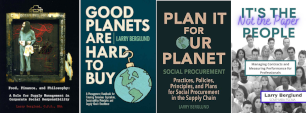Eating all of your enemies is not a sustainable diet. Consuming all of the resources in a supply chain is not a sustainable solution.
The holistic approach to sustainable supply chains needs to concurrently address environmental, economic and social values in all communities. Arguably, we’ve been teaching economics for 100+ years; we’ve been learning about the environmental issues for 50+ years; and we’ve been increasing our awareness on social values for ~10 years.
Each of these strategic components of western business practices were traditionally seen as being independent of each other in the supply chain. Largely because unfettered profits were good of all businesses, ergo people; whereas environmental and social interests were the responsibility of governmental agencies. This model appeared to work until storm clouds appeared in the form of smog, acid rain, contaminated drinking water, extirpation of species and other forms of degradation – much of which was non-reversible. That was the problem with this linear model – we were eating our future!
Recycling was the illusion where we could continue to consume low cost products using plastics as the main ingredient in the product and in the waste packaging. Once we were done with the products we could dispose of them and they would be wonderfully recycled. About 75% of plastics are buried in landfill sites. Recycling was a feel-good failure based on good intentions but poor science.
The problem with consumption of resources is not the fault of plastic alone – it can be traced to the design phase. Goods were designed-for-disposal. The linear economy was based on infinite resources which could be harvested in a continuous manner. Wrong! Recycling led to an increased consumption of poorly designed goods aimed at the lowest cost to produce, to increase profits. Eco-fees are another feel-good tactic to support consumptive behaviours.
The emergence of the circular economy acknowledges resources are finite; goods are designed-for-environment; energy should come from renewable sources; waste is eliminated; use of indigenous materials and local labour contribute to social values. For supply chain professionals, there is a duty to explore more responsible options which consider the total cost of ownership. For example, offshoring production to a low-cost producer which reduces local employment may not be the best trade off. While offshoring, in this example drives profits for an owner, the community which loses the jobs bears the cost – referred to as a zero-sum model. There is an economic benefit with a social value offset. Environmental responsibilities may be transferred to a region which has lax regulations. Not sustainable.
The circular economy is a long-term view where at the end of a life cycle for a product, all of the materials can be repurposed into a new product. At the design stage, products are planned for their inevitable deconstruction and use biomimicry as a template. Metals are recaptured. Toxic materials and chemicals are contained. There is a new role for recycling in the sense that it becomes the means to recover supply chain materials for reuse in a continuous cycle. The circular economy is a strategy for conservation. Supply chains in the future will be viewed as supply loops.
When we think of traditional sourcing risks we have geo-political issues as one of them. Most of our precious and primary metals are not available in domestic markets and often need to be imported from unstable political regions or involve exploitive labour practices. 75% of our energy requirements are used in the mining of materials or harvesting of resources. We’ve already spent the energy once – now let’s be more responsible and repurpose the materials we have already processed once into new products which reduces the energy demands.
To collect and segregate goods for inclusion in new products it will create an increase in domestic/local employment. This recycling activity will largely be provided by low-skilled workers in key locations. Social enterprises will play a larger role in supply chain models. Municipal organizations will fund critical infrastructure requirements to support private sector investment. Albeit, there will be a limit to the volumes and types of materials available through these centres initially but long-term they will contribute a higher percentage of materials for feedstock. Reverse logistics networks will add to the efficiencies required to collect and redirect materials.
The use of smart labeling or smart tags will help to track materials through their life cycle. This enables producers to retain control of their original materials where they choose to do so. 3D production or additive manufacturing, using locally recovered materials, reduces the dependency on imported materials or goods, reduces the associated transportation and energy requirements. Concurrently, it will address social values and environmentally responsible solutions.
While disruptive technology advances such as robotics reduces the need for labour input, the circular economy may create more employment opportunities. Increasing labour content and variable costs seems, counter-intuitive, in the long-term this may provide a transition from consumption-based economics to conservation-based economics.
Short-term it still appears cheaper to continue to extract raw resources where there is no collection and distribution infrastructure in place to adopt circular economy practices. But we can’t keep cannibalizing our future – it is not sustainable and therefore not profitable. The circular economy allows for an increase in economic activity without a corresponding demand in energy and environmental stress.
Fast fashion companies are among the early adopters of circular economy practices. But commercial and industrial players are also engaged. They can see the economic benefits being realized and can address environmental problems and contribute to social capital. Leaders such as Unilever, Caterpillar and Zara are sharing ideas to create greater value.
The circular economy doesn’t mean perfect solutions but can lead to better solutions. Better solutions meaning more responsible business practices across supply chains and increased accountability for the global resources.

